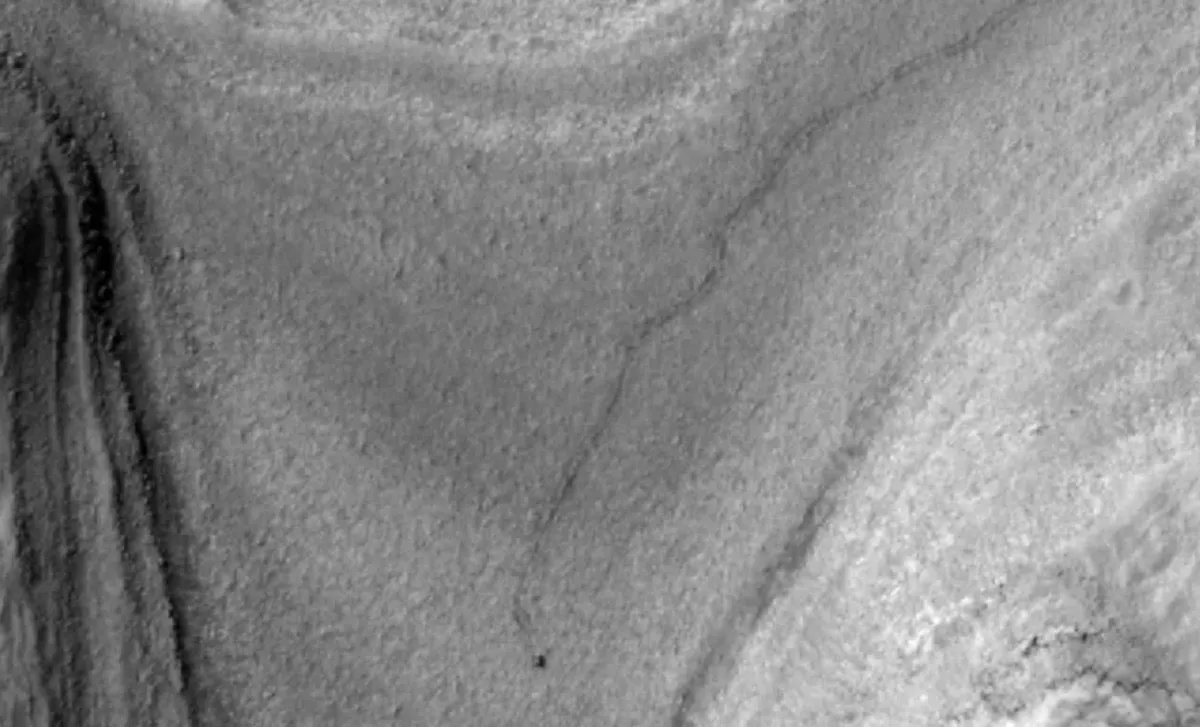
In a significant milestone for NASA’s ongoing exploration of Mars, an image captured on February 28, 2025, by the HiRISE camera aboard the Mars Reconnaissance Orbiter (MRO) reveals a small speck at the front of a trail of tracks extending over 1,050 feet (320 meters). This remarkable trail documents the Curiosity rover’s journey across the Martian landscape as it moves toward its next scientific destination. The image is part of a recent report from NASA’s Jet Propulsion Laboratory (JPL), underscoring the rover’s relentless pursuit of Mars’ ancient mysteries.
Captured after the Curiosity rover completed a journey of approximately 69 feet (21 meters) during its 4,466th Martian day, this photograph may represent the first-ever orbital image of the rover mid-drive, showcasing the latest advancements in space exploration technology. The tracks left behind on Mars are expected to persist for months before gradually being erased by the Martian winds.
Since its mission began in 2012, Curiosity has undertaken over a thousand drives across the Martian surface. Each drive is meticulously planned by the engineers at NASA’s Jet Propulsion Laboratory, who collaborate with scientists to define the rover’s daily objectives. The tracks highlighted in the HiRISE image reflect a series of 11 drives that commenced on February 2, with Curiosity moving at a top speed of just 0.1 miles per hour (0.16 kilometers per hour).
These drives are instrumental in bringing the rover closer to its next scientific destination, where researchers are eager to study a region of Mars thought to have been shaped by ancient groundwater billions of years ago. This area is known for its boxwork formations, structures believed to be created by groundwater processes, which could provide vital clues regarding the history of water on Mars and its potential habitability in the distant past.
As Curiosity approaches this new scientific location, scientists remain hopeful that investigations into these formations will yield groundbreaking insights into Mars’ ancient climate and whether it could have supported microbial life.
Since landing on Mars more than a decade ago, Curiosity has made remarkable progress in its mission to explore the Martian surface, studying its geology, atmosphere, and the potential for past life on the planet. Throughout its mission, Curiosity has provided invaluable data, including the confirmation of ancient lakes and the discovery of organic molecules on the Martian surface.
One of the most astonishing aspects of this mission is Curiosity’s ability to navigate the rugged and diverse terrain of Mars. Although its average speed is slow, its precise navigation and careful driving are crucial to the rover’s success. Equipped with advanced imaging systems and scientific instruments, Curiosity performs a wide array of tasks, ranging from rock analysis to taking selfies that document its journey and surroundings.
Doug Ellison, Curiosity’s planning team chief at JPL, emphasized the rover’s precision, stating, “By comparing the time HiRISE took the image to the rover’s commands for the day, we can see it was nearly done with a 69-foot drive.” This meticulous tracking of Curiosity’s movements ensures it remains on course for new discoveries, regardless of the challenges posed by Mars’ rugged landscape.
The latest image of Curiosity’s tracks highlights the rover’s continuous movement towards new scientific exploration. As it ascends a steep slope, Curiosity is gearing up to investigate an area of interest that may hold significant geological clues. In the coming weeks, it is anticipated that the rover will reach its new science destination, where researchers plan to conduct further studies on the boxwork formations shaped by ancient groundwater activity.
This area may provide critical information regarding the planet’s past climate and whether liquid water existed long enough to support life. The rover's drive toward this new location not only showcases its adaptability but also highlights the expertise of the planning team at JPL, who are well-prepared to tackle any obstacles presented by the terrain ahead, collaborating closely with scientists to adjust Curiosity’s route as necessary.